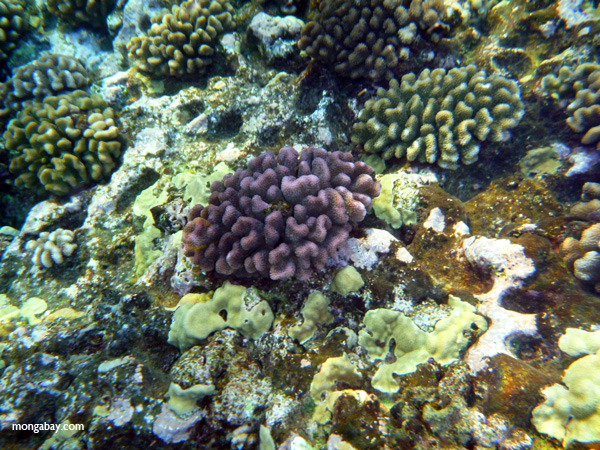
Coral reefs off Maui. The extra carbon sequestered by the oceans has put the world’s coral reefs at risk due to acidification. Photo by: Rhett A. Butler.
Even as humans emit ever more carbon dioxide into the atmosphere, Earth’s ecosystems are still sequestering about half, according to new research in Nature. The study finds that the planet’s oceans, forests, and other vegetation have stepped into overdrive to deal with the influx of carbon emitted from burning fossil fuels, but notes that this doesn’t come without a price, including the acidification of the oceans.
“We’re already seeing climate change happen despite the fact that only half of fossil fuel emissions stay in the atmosphere while the other half is drawn down by the land biosphere and oceans,” co-author Caroline Alden with the University of Colorado, Boulder said in a press release. “If natural sinks saturate as models predict, the impact of human emissions on atmospheric CO2 will double.”
The research found that while global carbon emissions quadrupled in the past 50 years, Earth’s carbon sinks doubled the amount of carbon they sequestered, lessening, but not neutralizing the warming impact of the carbon emissions into the atmosphere.
“What we are seeing is that the Earth continues to do the heavy lifting by taking up huge amounts of carbon dioxide, even while humans have done very little to reduce carbon emissions,” explains lead author Ashley Ballantyne, also with the University of Colorado, Boulder. “How long this will continue, we don’t know.”
To date, global temperatures have risen around 0.8 degrees Celsius (1.44 degrees Fahrenheit) due to greenhouse gas emissions, but that temperature rise would have been greater if not for the planet’s uptick in carbon sequestration.
“It is important to understand that CO2 sinks are not really sinks in the sense that the extra carbon is still present in Earth’s vegetation, soils and the ocean,” explains co-author Pieter Tans with the National Oceanic and Atmospheric Administration (NOAA). “It hasn’t disappeared. What we really are seeing is a global carbon system that has been pushed out of equilibrium by the human burning of fossil fuels.”
Sequestration of carbon can take its toll: the world’s oceans are acidifying due to the extra influx of carbon. This chemical change imperils coral reefs, the most biodiverse ecosystem in the oceans, and marine molluscs, which depend on calcium carbonate to build their shells, a mineral that becomes scarcer in more acidic oceans. Ocean acidification has become one trend—in addition to overfishing and pollution—that has led marine biologists to warn that the oceans could suffer a mass extinction event.
In the end, the researchers expect that eventually carbon sinks will fill up, putting any new emissions into the atmosphere.
“As the oceans acidify, we know it becomes harder to stuff even more CO2 into the oceans,” Tans says.
The only way to tackle climate change is to rapidly and aggressively cut global carbon emissions, according to scientists. However such emissions continue to rise: last year, emissions hit a new record of 34 billion tons.
Related articles
Scientists: iron fertilization could be a big climate help
(07/18/2012) For a long time, oceanic iron fertilization was seen as a promising mechanism to combat global climate change. But then in 2009 a well-publicized study found that iron fertilization stored 80 times less carbon than expected, dampening enthusiasm and support around the geoengineering scheme. Now, however, the idea of fertilizing the ocean with iron may be back: a new study in Nature reports that iron fertilization, in the right conditions, could store carbon in the deep ocean for centuries.
Pre-industrial deforestation still warming atmosphere
(07/03/2012) Fossil fuels were not burned in massive quantities prior to the Industrial Revolution, but humans were still pumping carbon into the atmosphere due to land use change, especially deforestation. In fact, a new study in Environmental Research Letters finds that deforestation prior to 1850 is still heating up our atmosphere today.
Warmer forests expel carbon from soils creating “vicious cycle”

(06/13/2012) As the world warms, temperate forests could become a source of carbon dioxide emission rather than a sink according to a new study in the Proceedings of the National Academy of Sciences (PNAS). Scientists found that two forest sites in the U.S. (Wisconsin and North Carolina) emitted long-stored carbon from their soils when confronted with temperatures 10-20 degrees Fahrenheit (5.5-11.1 degrees Celsius) higher than average.
Carbon dioxide hits 400 parts per million in Northern Hemisphere
(05/31/2012) Concentrations of carbon dioxide in the atmosphere have risen above 400 parts per million (ppm) in recording stations across the Arctic going as far south as Mongolia, reports the Associated Press. Such levels have not been seen in at least 800,000 years according to researchers. Carbon levels fluctuate depending on the region and the season and scientists say global concentrations will likely remain at around 395 ppm for the time being.
Seagrass beds store 20 billion tons of carbon

(05/22/2012) Just below the ocean’s surface lies a carbon powerhouse: seagrass meadows. New research in Nature Geoscience estimates that the world’s seagrass meadows conservatively store 19.9 billion metric tons of carbon, even though the threatened marine ecosystems make up only 0.2 percent of Earth’s surface. The findings lend support to the idea that seagrass protection and restoration could play a major role in mitigating climate change.